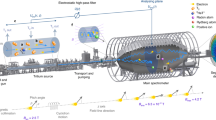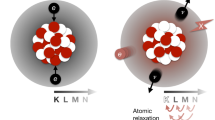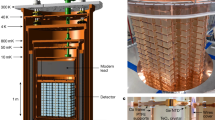Abstract
Many extensions of the standard model of particle physics suggest that neutrinos should be Majorana-type fermions—that is, that neutrinos are their own anti-particles—but this assumption is difficult to confirm. Observation of neutrinoless double-β decay (0νββ), a spontaneous transition that may occur in several candidate nuclei, would verify the Majorana nature of the neutrino and constrain the absolute scale of the neutrino mass spectrum. Recent searches carried out with 76Ge (the GERDA experiment) and 136Xe (the KamLAND-Zen and EXO (Enriched Xenon Observatory)-200 experiments) have established the lifetime of this decay to be longer than 1025 years, corresponding to a limit on the neutrino mass of 0.2–0.4 electronvolts. Here we report new results from EXO-200 based on a large 136Xe exposure that represents an almost fourfold increase from our earlier published data sets. We have improved the detector resolution and revised the data analysis. The half-life sensitivity we obtain is 1.9 × 1025 years, an improvement by a factor of 2.7 on previous EXO-200 results. We find no statistically significant evidence for 0νββ decay and set a half-life limit of 1.1 × 1025 years at the 90 per cent confidence level. The high sensitivity holds promise for further running of the EXO-200 detector and future 0νββ decay searches with an improved Xe-based experiment, nEXO.
This is a preview of subscription content, access via your institution
Access options
Subscribe to this journal
Receive 51 print issues and online access
$199.00 per year
only $3.90 per issue
Buy this article
- Purchase on Springer Link
- Instant access to full article PDF
Prices may be subject to local taxes which are calculated during checkout






Similar content being viewed by others
References
Majorana, E. Theory of the symmetry of electrons and positrons. Nuovo Cimento 14, 171–184 (1937)
Racah, G. On the symmetry of particles and antiparticles. Nuovo Cimento 14, 322–328 (1937)
Mourik, V. et al. Signatures of majorana fermions in hybrid superconductor-semiconductor nanowire devices. Science 336, 1003–1007 (2012)
Camilleri, L., Lisi, E. & Wilkerson, J. F. Neutrino masses and mixings: status and prospects. Annu. Rev. Nucl. Part. Sci. 58, 343–369 (2008)
Mohapatra, R. N. & Senjanovic, G. Neutrino mass and spontaneous parity violation. Phys. Rev. Lett. 44, 912–915 (1980)
Gell-Mann, M., Ramond, P. & Slansky, R. in Supergravity (eds van Nieuwenhuizen, P. & Freedman, D. ) 315–321 (North Holland, 1979)
Schechter, J. & Valle, J. Neutrinoless double-β decay in SU(2) x U(1) theories. Phys. Rev. D 25, 2951–2954 (1982)
Barabash, A. Precise half-life values for two-neutrino double-β decay. Phys. Rev. C 81, 035501 (2010)
Albert, J. B. et al. (EXO-200 Collaboration). An improved measurement of the 2νββ half-life of Xe-136 with EXO-200. Phys. Rev. C 89, 015502 (2014)
Vogel, P. Nuclear structure and double beta decay. J. Phys. G 39, 124002 (2012)
Agostini, M. et al. (GERDA Collaboration). Results on neutrinoless double-β decay of 76Ge from Phase I of the GERDA experiment. Phys. Rev. Lett. 111, 122503 (2013)
Gando, A. et al. (KamLAND-Zen Collaboration). Limit on neutrinoless ββ decay of 136Xe from the first phase of KamLAND-Zen and comparison with the positive claim in 76Ge. Phys. Rev. Lett. 110, 062502 (2013)
Auger, M. et al. (EXO-200 Collaboration). Search for neutrinoless double-beta decay in 136Xe with EXO-200. Phys. Rev. Lett. 109, 032505 (2012)
Klapdor-Kleingrothaus, H. & Krivosheina, I. The evidence for the observation of 0νββ decay: the identification of 0νββ events from the full spectra. Mod. Phys. Lett. A 21, 1547–1566 (2006)
Auger, M. et al. The EXO-200 detector, part I: Detector design and construction. J. Instrum. 7, P05010 (2012)
Redshaw, M., Wingfield, E., McDaniel, J. & Myers, E. G. Mass and double-beta-decay Q value of 136Xe. Phys. Rev. Lett. 98, 053003 (2007)
3M HFE-7000 http://www.3m.com (2014)
Esch, E.-I. et al. The cosmic ray muon flux at WIPP. Nucl. Instrum. Meth. A 538, 516–525 (2005)
Leonard, D. et al. Systematic study of trace radioactive impurities in candidate construction materials for EXO-200. Nucl. Instrum. Meth. A 591, 490–509 (2008)
Allison, J. et al. Geant4 developments and applications. IEEE Trans. Nucl. Sci. 53, 270–278 (2006)
Kotila, J. & Iachello, F. Phase-space factors for double-β decay. Phys. Rev. C 85, 034316 (2012)
Battistoni, G. et al. in Hadronic Shower Simulation Workshop (eds Albrow, M. & Raja, R. ) 31–49 (American Institute of Physics Conf. Ser. Vol. 896,. (2007)
Ferrari, A., Sala, P. R., Fasso, A. & Ranft, J. FLUKA: A Multi-Particle Transport Code (Program version 2005) (Tech. Rep. CERN-2005–010, SLAC-R-773, INFN-TC-05–11, CERN, 2005)
Wilson, W. B. SOURCES 4A: A Code for Calculating (α,n) Spontaneous Fission, and Delayed Neutron Sources and Spectra (Tech. Rep. LA-13639-MS, Los Alamos National Laboratory, 1999)
Bhat, M. in Nuclear Data for Science and Technology (ed. Qaim, S. ) 817–821 (Research Reports in Physics, Springer, 1992)
Rodríguez, T. R. & Martínez-Pinedo, G. Energy density functional study of nuclear matrix elements for neutrinoless ββ decay. Phys. Rev. Lett. 105, 252503 (2010)
Menéndez, J., Poves, A., Caurier, E. & Nowacki, F. Disassembling the nuclear matrix elements of the neutrinoless ββ decay. Nucl. Phys. A 818, 139–151 (2009)
Barea, J., Kotila, J. & Iachello, F. Nuclear matrix elements for double-β decay. Phys. Rev. C 87, 014315 (2013)
Šimkovic, F., Rodin, V., Faessler, A. & Vogel, P. 0νββ and 2νββ nuclear matrix elements, quasiparticle random-phase approximation, and isospin symmetry restoration. Phys. Rev. C 87, 045501 (2013)
Forero, D. V., Tórtola, M. & Valle, J. W. F. Global status of neutrino oscillation parameters after Neutrino-2012. Phys. Rev. D 86, 073012 (2012)
Ackerman, N. et al. (EXO-200 Collaboration). Observation of two-neutrino double-beta decay in 136Xe with EXO-200. Phys. Rev. Lett. 107, 212501 (2011)
Wilks, S. S. The large-sample distribution of the likelihood ratio for testing composite hypotheses. Ann. Math. Stat. 9, 60–62 (1938)
Cowan, G. Statistical Data Analysis (Oxford Science Publications, Clarendon, 1998)
Acknowledgements
EXO-200 is supported by the DOE and NSF in the United States, NSERC in Canada, SNF in Switzerland, NRF in Korea, RFBR (12-02-12145) in Russia and the DFG Cluster of Excellence ‘Universe’ in Germany. EXO-200 data analysis and simulation used resources of the National Energy Research Scientific Computing Center (NERSC), which is supported by the Office of Science of the US DOE under contract no. DE-AC02-05CH11231. The EXO-200 collaboration acknowledges the WIPP for their hospitality.
Author information
Authors and Affiliations
Consortia
Contributions
Each of the authors participated in the collection and analysis of the data reported here, with the following exceptions: D.B. contributed to the slow controls system; G.F.C. performed energy resolution simulations; X.S.J. and Y.B.Z. provided electronics expertise; M. Danilov, A.D., T.K. and P.V. contributed to the initial conception and design of the experiment; M. Danilov and A.D. also contributed to the acquisition of the xenon, while P.V. also advised on nuclear and particle theory; J.D., R.N. and A.R. provided engineering, operations and technical support at the WIPP facility; A.J., J.J.R. and A.W. supported data acquisition, data processing and software. In line with collaboration policy, the authors are listed here alphabetically. EXO-200 was constructed and commissioned by the authors of refs 15 and 31.
Ethics declarations
Competing interests
The author declare no competing financial interests.
Rights and permissions
About this article
Cite this article
The EXO-200 Collaboration. Search for Majorana neutrinos with the first two years of EXO-200 data. Nature 510, 229–234 (2014). https://doi.org/10.1038/nature13432
Received:
Accepted:
Published:
Issue Date:
DOI: https://doi.org/10.1038/nature13432
This article is cited by
-
Absolute neutrino mass scale and dark matter stability from flavour symmetry
Journal of High Energy Physics (2022)
-
Sterile neutrinos and neutrinoless double beta decay in effective field theory
Journal of High Energy Physics (2020)
-
Beta and neutrinoless double beta decays with KeV sterile fermions
Journal of High Energy Physics (2019)
-
Dihedral flavor group as the key to understand quark and lepton flavor mixing
Journal of High Energy Physics (2019)
-
Novel fused-silica charge detection tile for particle detectors
Radiation Detection Technology and Methods (2019)
Comments
By submitting a comment you agree to abide by our Terms and Community Guidelines. If you find something abusive or that does not comply with our terms or guidelines please flag it as inappropriate.



